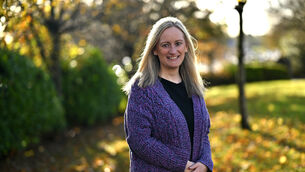Why mums are not latching on to breastfeeding

We know breastmilk is best for babies but often, when mums need support, it can be hard to find.
This can be true even when you work for the HSE. In its Breastfeeding Action Plan 2016-2021, the organisation states it supports mothers who want to continue breastfeeding on return to work. Yet a former employee is taking a case to the Workplace Relations Commission, saying the HSE failed to provide suitable facilities for her to express milk for her baby.
Could this lack of support help explain why Ireland has one of the lowest rates of breastfeeding in the world? In 2019, 60% of mothers here initiated breastfeeding, compared with 90% in Australia and 81% in Britain.
Of that figure, many did not persevere. Within 72 hours of discharge from hospital, 42.2% were breastfeeding exclusively. Three months later, the number had dropped to 31.2%.
This is despite the World Health Organisation’s recommendation for all babies to be breastfed exclusively for six months, and for breastfeeding to continue as part of the infant’s diet for at least two years.
Breastmilk offers proven health benefits to babies and mothers. A 2016 report in The Lancet — Breastfeeding in the 21st Century — examined all of the available evidence and concluded that breastfed children have a lower incidence and severity of many illnesses including respiratory and urinary tract infections, gastroenteritis, diabetes, and childhood cancers. In mothers, breastfeeding was found to help prevent breast cancer and reduce the risk of ovarian cancer and diabetes.
Krysia Lynch, chair of the Association for Improvements in the Maternity Services, says breastmilk is created specifically for a baby’s needs. “In addition to nutrients, it contains antibodies, beneficial bacteria, and enzymes that kickstart a newborn’s immune system. Colostrum [which is produced in the days immediately following birth] is packed to the hilt with these, and protects the baby as it adjusts to life outside the womb. Long and short, breastfeeding has the capacity to impact a baby’s health for a lifetime.”
SOCIOECONOMIC STATUS
This message may not be reaching all mothers. Dr Louise Gallagher is an assistant professor in midwifery in Trinity College Dublin and a lactation consultant. Her study of national breastfeeding rates shows a significant variation depending on socioeconomic status.
“Breastfeeding initiation rates in the National Maternity Hospital are 78%, and in Donegal, they are 45%,” she says. “Women who have a higher education and income are more likely to breastfeed. Donegal has Ireland’s highest number of medical cardholders, so we can surmise that most women there are not on a high income.”
There are reasons why education and income matter, according to Caoimhe Whelan, a Cuidiú breastfeeding counsellor and a lactation consultant. “They mean better access to information, more confidence to make the decision to breastfeed, and the means to access private lactation consultant support if necessary,” she says.
Starting breastfeeding is one thing, but continuing is quite another. “Lots of women stop because of a lack of understanding of what normal newborn behaviour looks like,” says Whelan.
Most mothers who stop do so between two and six weeks postpartum, which is when their baby is likely to have several growth spurts. “A baby this age will feed eight to ten times a day and a couple of times at night,” says Gallagher. “Women and families who have no experience of breastfeeding need to be told this is normal.
Otherwise, they will come to the logical conclusion that the baby is feeding so much because they have a low supply.”
Pain while feeding is another reason women stop. Lynch wants mothers to know this can be remedied, with help. “Small things like changing the way the baby is held or how the baby is latched on or off the breast can make a big difference,” she says.
Mothers need support at this crucial time. “The success of breastfeeding is not solely the responsibility of mothers,” says Whelan. “Many entities have a job to do.”
The maternity hospitals, for one. In 2012, all maternity hospitals implemented the National Infant Feeding Policy, which states that hospitals must protect, support, and promote best practice in relation to breastfeeding.
“Immediately postpartum, mother and baby should spend at least one hour skin to skin, during which time the baby will usually initiate breastfeeding,” says Lynch.
Back on the postnatal ward, midwives are expected to help with breastfeeding with lactation consultants on hand for more complex issues. When mothers are going home, they should be provided with a list of breastfeeding supports in their community.
The Baby-Friendly Hospital Initiative used to accredit hospitals that were following these guidelines, says Whelan. “Since it lost its funding in 2017, there has been no independent assessment of maternity units, which is a problem.”
Public health nurses can help once women return home. “However, they have a lot to cover and only a certain amount of time available,” says Lynch.
ONGOING SUPPORT
Many women reach out for supplementary support. This can come from private lactation consultants, postnatal doulas, or from voluntary groups such as La Leche League, Cuidiú, and Friends of Breastfeeding.
Gallagher believes further investment in health, government policy, GP training, lactation consultants, and peer support is required if we want more mothers to start and continue breastfeeding.
“Society has to become more informed,” she says. “It is vital that every woman gets to make a real choice about how she feeds her baby and is fully supported in that choice.”
How vital is underlined by a 2015 study that found mothers who decided to breastfeed but were unable to, had double the risk of postnatal depression of mothers who were able to breastfeed.
“This shows how necessary it is to provide expert support to women who want to breastfeed, and compassionate support to those who want to and find themselves unable,” says Gallagher.
Of those women who do manage to breastfeed for the recommended six months, many do not realise the benefits of continuing for longer.
“They are unaware of WHO guidelines on breastfeeding to age two and beyond,” says Sharon Beehan, a spokesperson for La Leche League. “They don’t know the benefits it brings.”
A 2001 study, Nutrition, Growth, and Complementary Feeding of the Breastfed Infant, found that breastmilk provided substantial amounts of key nutrients beyond the first year of life. A 448ml feed provided 29% of a two-year-old’s energy needs and 43% of protein as well as significant amounts of calcium, vitamin A, folate, vitamin B12, and vitamin C.
While a lack of information may account for some of the drop-off in breastfeeding at six months, the fact that many mothers return to work at this point is also a factor.
The law is behind the times when it comes to breastfeeding mothers. Under the Maternity Protection Act 2004, breastfeeding mothers are entitled either to breastfeeding breaks in the workplace, where suitable facilities are provided, or to a reduction of one working hour per day, without loss of pay, for up to 26 weeks after birth.
“Given that women receive 26 weeks of paid maternity leave, this law makes no sense,” says Lynch. “It legislates for women who are not even in the workplace.”
Some sectors offer more supports. Women who work in the civil service or for the Department of Education are entitled to breastfeeding breaks until their child’s second birthday.
In response to a query from Feelgood about the case before the Workplace Relations Commission, the HSE said it could not comment on the specific case but said it had drafted a policy on breastfeeding in the workplace that will give employees time, space, and support to breastfeed until their child’s second birthday. The final approval for this policy is due shortly.
The Irish Congress of Trade Unions is campaigning for these breastfeeding entitlements to be extended to all workers. “Legislation should make breastfeeding easier for everyone,” says Lynch.
The changes to work practices as a result of Covid-19 may also affect breastfeeding rates. “Anecdotally, I am hearing that more women are breastfeeding now that they have more time working from home,” says Gallagher. “It will be interesting to see if this has a long-term effect.”
A point raised by everyone interviewed for this article was that mothers should be supported in every way possible to see if breastfeeding worked for them and to continue for as long as they liked if it did.
BABY BONDING
Not all women can breastfeed. They may have serious illnesses or infections. They may be taking certain medications or receiving radiation therapy. Or they may have been advised to stop to counter postpartum depression.
There are also women who find breastfeeding too difficult or impractical. None should be berated for their choices.
According to a 2019 study published in the Journal of Pregnancy and Childbirth, how you feed does not affect bonding. Whether you feed your child formula, expressed milk from a bottle, or milk directly from your breast, the warmth of your arms and the reassurance of your gaze is what builds the bedrock of your connection.
This will come as a relief to women who cannot breastfeed, or who choose not to. So will the fact that formula is designed to be as close a match as possible to breastmilk. It contains similar amounts of carbohydrates, proteins, and calories and babies can — and do — thrive on it.
How a woman feeds her baby is a personal decision. “Nobody is dismissing any woman’s choice,” says Gallagher. “It is just that everyone needs to be fully informed and supported in those choices.”
In Ireland, we are behind on this, says Whelan. “[The tradition of] breastfeeding was broken here, and several generations did not do it. As a result, so much wisdom and knowledge were lost, and so too was the acceptance of breastfeeding as the normal way to feed a baby. We are in a process of relearning and we still have a way to go.”

Unlimited access. Half the price.
Try unlimited access from only €1.50 a week
Already a subscriber? Sign in
CONNECT WITH US TODAY
Be the first to know the latest news and updates

Celebrating 25 years of health and wellbeing







